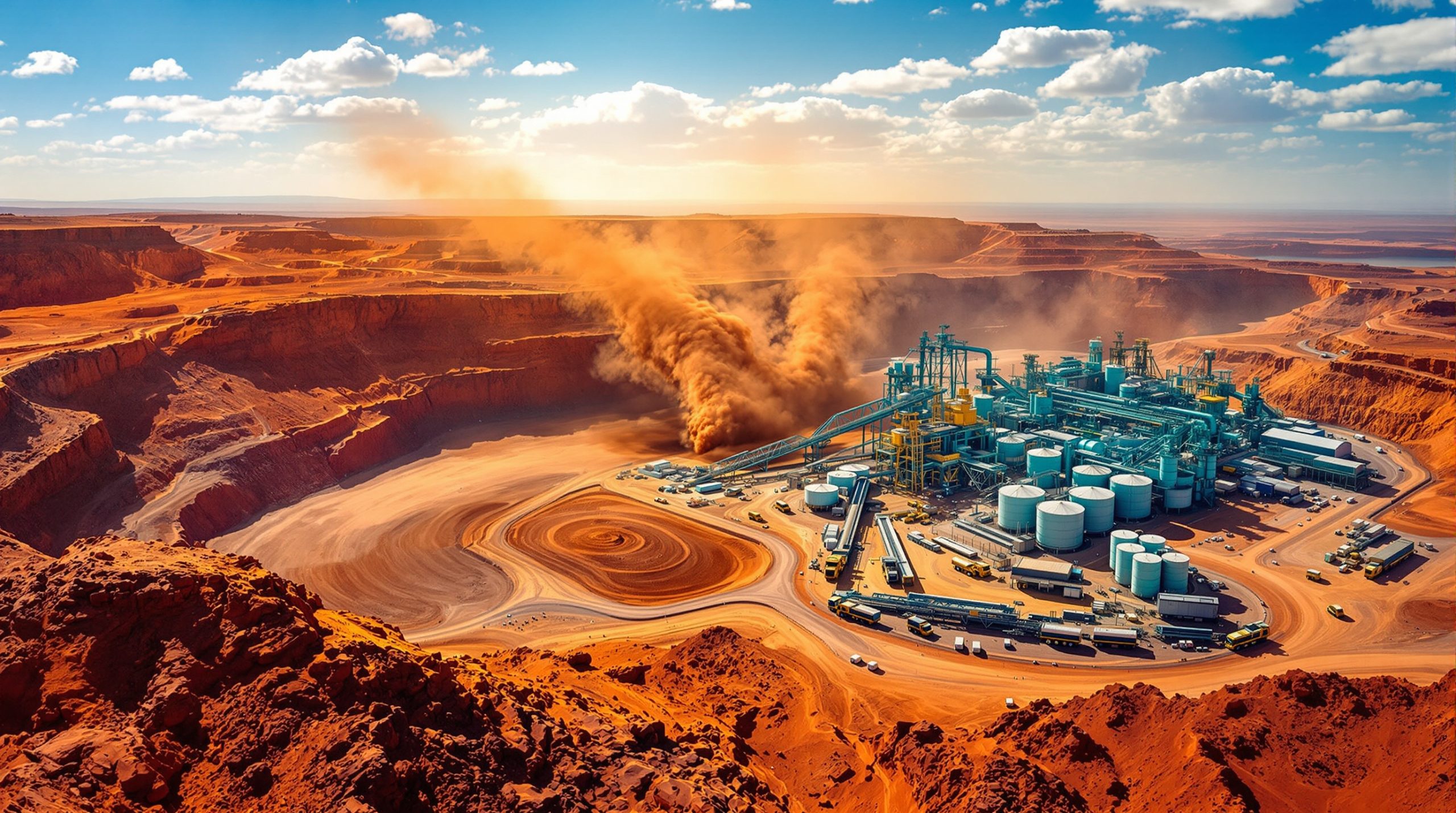Glencore's Ulan Coal Mine Expansion: Federal Approval and Environmental Implications
The Ulan Coal Mine expansion project, officially known as "Ulan Coal Modification 6 – Underground Mining Extension," represents Glencore's strategic effort to extend the operational lifespan of its coal mining complex in New South Wales. This modification enables the mining giant to access previously untapped coal reserves through expanded underground longwall mining operations and supporting infrastructure development.
Key Components of the Expansion Plan
The federal approval granted on August 28, 2025, extends mining operations until 2035, adding two years to the previously scheduled end date of 2033. This modification allows Glencore to extract approximately 18.8 million additional tonnes of coal reserves that would otherwise remain unmined.
The expansion focuses primarily on underground longwall mining operations, which is a highly mechanized form of coal extraction that allows for efficient recovery of deep coal seams while minimizing surface disturbance compared to open-pit mining methods.
Supporting infrastructure development includes upgrades to existing coal handling facilities, ventilation systems, and water management infrastructure essential for safe and efficient underground operations.
Location and Regional Context
The Ulan Coal Complex is situated in the central west region of New South Wales, approximately 38 kilometers north of Mudgee. This area has supported coal mining activities for decades due to its significant deposits of high-quality thermal coal suited for electricity generation.
The region's geological characteristics make it particularly suitable for underground mining, with coal seams that extend deep beneath the surface. The existing rail infrastructure provides direct transportation links to Newcastle port, facilitating export operations.
How Did the Federal Government Approve the Expansion?
Timeline of the Approval Process
The expansion project received federal approval on August 28, 2025, when the Department of Climate Change, Energy, the Environment and Water granted permission for the modification plan. This federal approval followed earlier state-level authorization from the NSW Department of Planning, Housing and Infrastructure, which had already given its consent in May 2025.
The dual approval timeline reflects Australia's multi-tiered regulatory approach, where projects must satisfy both state and federal requirements before proceeding. The process typically involves:
- Initial application and environmental impact statement preparation
- Public exhibition period allowing community feedback
- Response to submissions and potential plan modifications
- State assessment and determination
- Federal review of matters of national environmental significance
- Final federal determination
Regulatory Framework and Assessment Criteria
The federal assessment focused primarily on the project's potential impacts on matters protected under the Environment Protection and Biodiversity Conservation Act 1999 (EPBC Act). Key assessment criteria included:
- Impacts on threatened species and ecological communities
- Effects on water resources, particularly in relation to the water trigger for coal projects
- Consistency with Australia's international environmental obligations
- Cumulative impacts when considered alongside other developments
The NSW state assessment evaluated the proposal against the Environmental Planning and Assessment Act 1979, considering factors such as:
- Compatibility with local and regional planning instruments
- Social and economic benefits weighed against environmental impacts
- Land use compatibility and community impacts
- Adequacy of proposed mitigation measures
State vs. Federal Approval Requirements
The dual approval process highlights Australia's multi-tiered regulatory approach to resource projects:
State approval focuses on regional planning considerations, local environmental impacts, and compatibility with state development plans. The NSW Department of Planning, Housing and Infrastructure attached 13 conditions to its approval, covering biodiversity, greenhouse gas emissions, water usage, and Aboriginal cultural heritage protection.
Federal approval centers on matters of national environmental significance under the EPBC Act. This includes protection of threatened species, ecological communities, water resources, and ensuring compliance with Australia's international environmental commitments.
What Environmental Conditions Were Imposed?
Biodiversity Management Requirements
The federal approval includes strict conditions focused on protecting biodiversity values potentially affected by the mining operations:
- Development and implementation of a comprehensive biodiversity management plan that identifies, protects, and monitors sensitive ecological areas
- Special protection measures for the large-eared pied bat (Chalinolobus dwyeri), a vulnerable species with habitat in the project area
- Conservation of native grassland ecosystems surrounding the mining operations
- Regular monitoring and reporting on biodiversity outcomes
The large-eared pied bat protection is particularly significant as this species is vulnerable to extinction and relies on specific habitat features that can be impacted by mining operations, including sandstone cliff faces and mature forest habitat.
Land Clearing Restrictions
Specific limitations on vegetation clearing include:
- Maximum clearing allowance of 17.4 hectares of large-eared pied bat foraging habitat
- Restriction to clear no more than 5.9 hectares of white box, yellow box, and Blakely's red gum grassy woodland (an endangered ecological community)
- Sequential clearing requirements that allow wildlife to relocate naturally
- Rehabilitation obligations to restore disturbed areas after mining operations
These restrictions are designed to minimize habitat fragmentation and preserve critical ecological communities that support diverse flora and fauna species in the region.
Water Management Obligations
To protect water resources, Glencore must:
- Implement a comprehensive water management plan that addresses both surface and groundwater impacts
- Conduct regular monitoring of groundwater and surface water systems to detect any changes in quality or quantity
- Publish monitoring program results at least annually for public transparency
- Mitigate potential impacts on local water systems and aquifers through engineered controls
- Establish trigger levels that require immediate action if exceeded
The water management plan is particularly important in the context of underground longwall mining, which can cause subsidence and potentially alter groundwater flow patterns and surface water drainage.
What Are the Economic Implications of the Expansion?
Employment and Regional Economic Benefits
The extension of mining operations at Ulan will maintain existing employment opportunities that would otherwise be lost if the mine closed in 2033 as previously scheduled. This continuation provides economic stability for:
- Several hundred direct mine employees and their families
- Local contractors providing services ranging from maintenance to catering
- Regional businesses dependent on mining activity, including retail, hospitality, and housing sectors
- Local government through continued rate payments and infrastructure contributions
Mining operations in regional areas typically create a significant economic multiplier effect, where each direct mining job supports additional positions in the broader community through indirect and induced employment.
Coal Production and Export Potential
The additional 18.8 million tonnes of coal represents significant export value for Australia's resources sector. Based on current thermal coal prices, this production extension could generate:
- Hundreds of millions in export revenue over the extended mine life
- Substantial royalty payments to the NSW government
- Continued tax contributions to federal and state treasuries
- Supply certainty for international energy customers
Australia's high-quality thermal coal remains in demand in key Asian markets despite the global energy transition, particularly in countries still developing their renewable energy capacity.
Infrastructure Utilization
The expansion leverages existing mining infrastructure, maximizing the return on previous capital investments in:
- Coal handling and preparation plants
- Rail loading facilities and transportation networks
- Ventilation and safety systems
- Administrative buildings and maintenance workshops
- Water management systems and environmental controls
This efficient utilization of already-developed assets reduces the need for new construction and helps minimize the project's overall environmental footprint compared to developing an entirely new mine site.
What Environmental Concerns Have Been Raised?
Greenhouse Gas Emission Implications
The expansion has drawn criticism due to its climate impact implications:
- When burned, the additional 18.8 million tonnes of coal will generate approximately 41 million tonnes of CO₂ equivalent emissions
- These emissions will predominantly occur as Scope 3 emissions when the coal is used overseas
- Critics argue this conflicts with Australia's broader climate commitments, including its pledge to reduce emissions by 43% by 2030
- The approval comes amid growing international pressure for countries to phase out fossil fuel developments
Environmental groups have highlighted that approving new coal expansions makes achieving national and global climate targets increasingly difficult, as the operational lifetime of these projects locks in emissions for decades.
Habitat Fragmentation and Biodiversity Impact
Environmental groups have expressed concerns about:
- Disturbance of approximately 634 hectares of land throughout the project area
- Impacts on threatened ecological communities, including endangered woodland ecosystems
- Potential long-term effects on local wildlife corridors and habitat connectivity
- Cumulative impacts when considered alongside other developments in the region
Even with restricted clearing allowances, the expansion will contribute to ongoing habitat fragmentation in an area that has already experienced significant ecological disturbance from historical mining activities.
Water Resource Concerns
The underground mining expansion raises questions about:
- Potential impacts on groundwater systems, including drawdown of aquifers
- Changes to surface water flows due to subsidence from underground mining
- Long-term water quality in the surrounding catchment
- Competition for water resources in a region prone to drought conditions
Longwall mining is known to cause subsidence of overlying strata, which can alter groundwater flow patterns and potentially affect surface water features. Critics argue that these impacts may persist long after mining operations conclude.
How Does This Approval Align With Climate Policy?
Tension With National Climate Commitments
The approval highlights ongoing tensions between Australia's resource development priorities and climate action commitments:
- Australia has pledged to reduce emissions by 43% below 2005 levels by 2030
- The country aims to achieve net zero emissions by 2050
- Continued approval of fossil fuel projects creates challenges for meeting these targets
- Critics argue that new coal developments are inconsistent with global climate goals established under the Paris Agreement
This tension reflects broader challenges faced by resource-dependent economies navigating the global energy transition while maintaining economic stability and energy security.
Policy Framework Considerations
The decision reflects Australia's current approach to emissions accounting, which:
- Focuses primarily on domestic (Scope 1 and 2) emissions in national targets
- Does not fully account for exported emissions (Scope 3) when coal is burned overseas
- Balances economic considerations with environmental objectives
- Prioritizes gradual transition rather than immediate cessation of fossil fuel development
Australia's policy position maintains that importing countries, not exporters, should account for emissions from burning fossil fuels, consistent with international emissions accounting frameworks.
International Context and Market Dynamics
The approval occurs within a complex global context where:
- International demand for thermal coal continues despite climate concerns, particularly in developing Asian economies
- Energy transition timelines vary significantly between countries, with some nations still heavily reliant on coal for baseload power
- Australia maintains its position as a major global coal supplier, arguing that its high-quality coal produces fewer emissions per unit of energy than alternatives
- Global financial institutions are increasingly restricting funding for new coal developments, though existing operations often remain viable
Market analysts note that even as global coal consumption is projected to decline in coming decades, high-quality Australian thermal coal may maintain market share longer than lower-grade alternatives due to coal supply challenges in many regions.
What Legal Challenges Might the Project Face?
Potential Grounds for Legal Action
Environmental organizations have indicated possible legal challenges on several grounds:
- Adequacy of climate impact assessments in the approval process
- Procedural compliance with environmental protection laws
- Consideration of intergenerational equity principles
- Proper assessment of impacts on matters of national environmental significance
Recent court decisions have established that climate impacts must be meaningfully considered in project approvals, creating potential avenues for legal challenge.
Recent Precedents in Mining Approvals
Recent court decisions have established precedents requiring:
- More comprehensive consideration of climate impacts in project approvals, including Scope 3 emissions
- Assessment of local climate change effects from resource projects
- Stronger evidence-based decision-making in environmental approvals
- Application of the "precautionary principle" where scientific uncertainty exists about environmental impacts
Notable cases such as Sharma v. Minister for Environment and Gray v. Minister for Planning have established important legal principles regarding climate considerations in project approvals.
Regulatory Evolution and Future Implications
The legal landscape for mining approvals continues to evolve with:
- Increasing judicial scrutiny of approval processes
- Growing emphasis on climate considerations in environmental law
- Potential for new precedents that could affect similar projects
- Evolving standards for what constitutes adequate environmental assessment
These changing legal standards create uncertainty for resource projects with long development and operational timeframes, potentially affecting investment decisions for future coal developments.
What Is Glencore's Position on the Expansion?
Corporate Justification for the Project
Glencore has characterized the expansion as:
- A minor modification to existing operations rather than a new development
- Necessary for efficient resource recovery and avoiding sterilization of viable coal reserves
- Consistent with responsible mine planning and development
- An extension that maximizes the value of existing infrastructure and prior investments
The company emphasizes that the expansion primarily involves underground operations that have substantially lower surface impacts than open-cut mining methods.
Sustainability Commitments and Practices
The company has emphasized its commitment to:
- Implementing best-practice environmental management
- Meeting all regulatory requirements and conditions
- Balancing resource development with environmental protection
- Progressively reducing operational emissions across its global portfolio
Glencore has publicly committed to reducing its total emissions (Scope 1, 2, and 3) by 15% by 2026 and 50% by 2035, with a net-zero target by 2050, though critics question how these commitments align with ongoing coal expansions. The company has also highlighted its investment in sustainability transformation initiatives across its global operations.
Long-term Strategy Considerations
The Ulan expansion fits within Glencore's broader corporate strategy, which includes:
- Maximizing value from existing assets
- Maintaining diversity across its global portfolio of commodities
- Gradually transitioning toward future-focused commodities including copper, cobalt, and nickel
- Positioning coal assets for responsible depletion while managing the transition to lower-carbon operations
As one of the world's largest diversified resource companies, Glencore has indicated plans to gradually reduce its coal exposure over time while maintaining that high-quality thermal coal remains essential during the global energy transition. This approach differs somewhat from the BHP coal strategy which has seen that company divest from thermal coal assets in recent years.
FAQ: Glencore's Ulan Coal Mine Expansion
How much additional coal will be extracted through this expansion?
The expansion will allow Glencore to access approximately 18.8 million tonnes of additional coal reserves that would otherwise have remained unmined. This represents a relatively small but economically significant extension of the mine's productive capacity.
When will the expanded mining operations conclude?
Under the new approval, mining operations at the Ulan Coal Complex can continue until 2035, representing a two-year extension from the previous end date of 2033. This timeline reflects the expected duration needed to extract the additional coal reserves at projected production rates.
What specific environmental protections are required?
The approval mandates comprehensive biodiversity and water management plans, strict land clearing limits, protection measures for threatened species (particularly the large-eared pied bat), and regular public reporting of environmental monitoring data. These conditions are designed to minimize and mitigate potential impacts throughout the extended operational period.
How will local communities be affected by the extension?
Local communities will experience continued employment opportunities and economic activity that would otherwise have ceased in 2033, along with ongoing environmental management requirements to minimize impacts. The extension provides additional time for regional economic planning and workforce transition strategies.
Does this approval conflict with Australia's climate commitments?
Critics argue the approval creates tension with Australia's climate goals, as the additional coal will generate significant greenhouse gas emissions when burned, predominantly overseas. However, supporters note that under international accounting frameworks, these Scope 3 emissions are attributed to the countries where the coal is consumed, not Australia as the exporter.
What precedent does this approval set for other coal projects?
The approval suggests Australia's regulatory framework continues to allow coal mine expansions when they meet environmental management requirements, despite growing climate concerns. However, each project is assessed on its specific merits, and the evolving legal landscape means future proposals may face different evaluation criteria as mining permitting basics continue to evolve.
Balancing Resource Development and Environmental Protection
The federal approval of Glencore's Ulan coal mine expansion highlights the ongoing challenge of balancing resource development with environmental protection and climate considerations. While the project will deliver economic benefits through extended mine life and continued employment, it also raises significant questions about Australia's commitment to reducing greenhouse gas emissions and protecting biodiversity.
The strict environmental conditions attached to the approval reflect growing regulatory emphasis on minimizing ecological impacts, but critics argue these measures are insufficient given the climate implications of continued coal production. As Australia navigates the complex transition toward a lower-carbon economy, decisions like this one illustrate the tensions between immediate economic interests and longer-term environmental sustainability.
This approval occurs at a pivotal moment in Australia's energy transition, with the country simultaneously pursuing ambitious renewable energy targets while maintaining its position as a major global fossil fuel exporter. The Ulan extension, while modest in scale compared to some new coal developments, nevertheless represents continued investment in fossil fuel infrastructure at a time when climate scientists emphasize the urgency of reducing carbon emissions.
For investors and industry observers, the approval signals that Australia's regulatory framework continues to accommodate incremental extensions of existing coal operations, even as the global energy landscape evolves. However, the increasing scrutiny of such approvals, growing legal challenges, and shifting market dynamics suggest that the long-term outlook for thermal coal remains uncertain.
The Ulan expansion approval may well become a focal point in ongoing debates about Australia's resource policy, climate commitments, and environmental protection frameworks. How these competing priorities are balanced will significantly influence the country's energy and resource development landscape in the years ahead, including approaches to mine reclamation innovation that will be critical once these operations eventually conclude.
Interested in Staying Ahead of Market-Moving ASX Mineral Discoveries?
Discovery Alert's proprietary Discovery IQ model delivers instant notifications when significant mineral discoveries are announced on the ASX, turning complex data into actionable investment insights. Visit the Discovery Alert discoveries page to see how historic discoveries have generated substantial returns and begin your 30-day free trial today.




